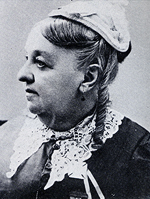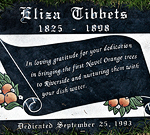
Tibbets house on Central Avenue with the parent navel orange trees behind barbed wire
Born Eliza Lovell in Cincinnati, Eliza was married twice before she met Luther, first to a Mr. Summons with whom she had her son James B. Summons, and second to Dr. Neal, with whom she moved to New York City in 1861.
A spiritualist who cultivated the appearance of Queen Victoria, according to local historian Tom Patterson, Eliza “indulged in seances and other exotica.” According to local stories, she “remained behind in Washington, D.C. while her husband prepared the homestead, and she arrived with Riverside’s first known black resident, the mysterious little girl known only as Nicey. Possibly the product of a Civil War dalliance on the part of Eliza’s son, James, Nicey’s background always remained discreetly shrouded in Victorian silence.”
Usually the facts of Eliza’s story are discretely handled; presumably it was the Daughters of the American Revolution after all, who arranged for the plaque that accompanies the city’s “parent navel orange tree.” Nevertheless, when she arrived in Riverside, Eliza was not Luther Tibbets’s wife. For more than a year she lived with her son and his wife, Luther’s daughter Harriet, before Lyman C. Waite, a Justice of the Peace, could finalize “arrangements” for Eliza and Luther to live together.
The first navel orange trees were imported into the United States by William Saunders of the Department of Agriculture in 1870. Before leaving Washington, Eliza persuaded Saunders, a friend, to ship two of the navel orange trees that originated in Bahia Province, Brazil, to the Tibbets home in Riverside. The trees were planted in 1874-5. Anecdotes have it that Eliza nurtured the little trees with her dishwater. “Upon maturing the fruit was found to be superior in every way. Bud sales were brisk, and the two trees, ringed with barbed wire, became famous. Although officially called the Bahia, the fruit was soon dubbed the Riverside Navel, and its popularity eventually made Riverside a citrus center and prosperous showplace.” Eliza’s dishwater story pointed to the early colony’s most important commodity—water.
The rise of the citrus industry is more the doing of the Tibbets’s neighbor, Samuel McCoy, who with his partner, Cyrus Cover owned 20 acres next door to Eliza and Luther. McCoy cut a bud from one of Eliza’s trees and grafted it to an orange seedling of his own and it fruited before the original trees. Cover and McCoy budded about 10 acres as soon as they could get buds and the navel industry was on its way.
Tom Patterson explains, “The founding families usually had, or tried very hard to display the Victorian virtues of piety, hard work, sound family life and obedience to authority. But the Victorian age was not a monolith.” This is a masterstroke of understatement as it applies to Luther and Eliza Tibbets and family.
In understanding Eliza, Spiritualism is a starting place. It “wasn’t atheism,” Patterson says, “but almost as bad and more aggressive. Riverside had a considerable minority of Spiritualists with whom it was permissible to mix socially, despite disapproval.” Among the details Patterson collected, many concern Eliza: “Founder and Mrs. North, not being entirely conventional, once invited the celebrated Mrs. Eliza Tibbets to their home, where she went so far as to conduct a seance,” and on another occasion, invited to stay overnight at the North’s, she “conducted a seance during which she called upon her friendly spirit, an Indian girl named Floating Feather, invisible to others. … In later years she developed a keen interest in Catholicism, but not to the exclusion of Spiritualism. Despite a schism among Riverside Spiritualists, both her supporters and her opponents within the movement regarded her as a potent medium.” He adds, “while most of the … [Spiritualists] left Riverside early, Mrs. Tibbets and her husband remained, and she frequented Spiritualist colonies elsewhere.”
Eliza’s appearance seems to have been as curious as Luther’s, and a way to connect her spiritual and social aspects: “She was thought to look like Queen Victoria. She was proud of it, and accented it in her clothes. One of her social talents was that of the Gypsy fortune teller at money-raising events. At one such event, for the Library Association, [it was] later recalled that Mrs. Tibbets ‘entered into the spirit of the thing whole-heartedly and her tent was the most popular booth in the hall.’”
Among the socializing events, Patterson includes early citrus shows and mentions “a highly informal one” in 1878 where Mrs. “Tibbets displayed the navel orange for the first time … and handed out samples for tasting.” He makes it very clear that “Eliza herself was not fully in the Riverside mold, but was certainly more acceptable socially than Luther. … Mrs. Tibbets formed in Riverside what [historian E.W.] Holmes called ‘a little group of intellectuals and free thinkers.’”
With Luther, Eliza’s fortunes rose and waned. Her health and the welfare of her family seemed to connect. The pair went bankrupt in 1878, the same year the granddaughter they had raised for years drowned in a tragic accident. In 1898 creditors foreclosed on the Tibbets’s property. Eliza had always been a sufferer of asthma but developed other medical problems as well. She “was invited to stay with friends in the Spiritualist colony at Summerland, near Santa Barbara. She died in a Santa Barbara hospital July 14, 1898” at the age of 73.
Clearly there was an oversight when the plaque accompanying the first “parent navel orange tree” was erected. In fact, there are two monuments and two markers, two small parks to memorialize two people—Eliza and Luther Tibbets. “Both markers say the trees were planted in 1873. Both were erected years after the Tibbetses were dead. Both before and after the plaques were cast in bronze, Riverside oldtimers in a good position to know were saying that the original planting was not in 1873 but in the spring of 1875.” For years, citizens committees and horticulturalists, the U.S. Dept. of Agriculture and family members have wrangled over details of the acquisition and planting. The most unfortunate part of this battle is the injustice done to the two people most responsible for the navel orange in Riverside, Luther and Eliza.
Minnie Tibbets Mills, in her attempt to dignify her father, “downgraded Eliza with such phrases as ‘the woman who was working his ruin.’ She wrote, with a degree of truth, no doubt, that Eliza was ‘brilliant, unprincipled, ambitious’ and that she ‘saw in Mr. Tibbets the mine of gold which she needed to make her dreams a reality.’” In fact, Patterson concludes, “Eliza was certainly not unprincipled, and Luther turned out to be no gold mine.”




